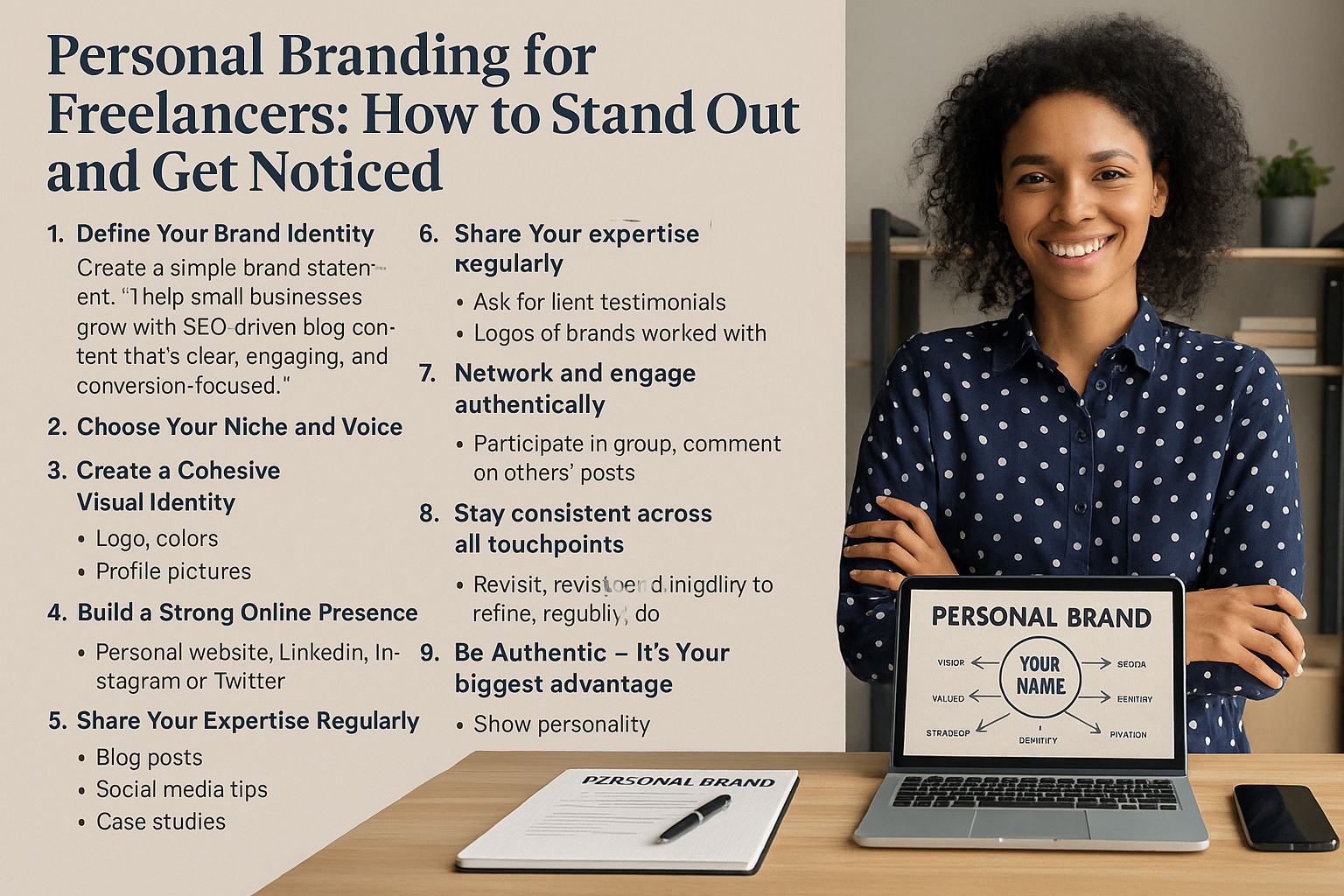In a crowded freelance market, your skills alone aren’t enough. To consistently attract clients and charge what you’re worth, you need a strong personal brand. Whether you’re a writer, designer, developer, or virtual assistant, personal branding helps you stand out, build trust, and create long-term opportunities. In this article, we’ll explore what personal branding is, why it matters, and how freelancers can craft a memorable brand that attracts the right clients.
What Is Personal Branding?
Personal branding is the perception people have of you professionally—your reputation, expertise, values, and personality combined. It answers the question:
“Why should someone choose to work with YOU instead of someone else?”
Your personal brand helps people:
- Remember you
- Trust you faster
- Pay more for your services
- Recommend you to others
1. Define Your Brand Identity
Start by clarifying who you are and what you offer.
Ask yourself:
- What are my core values?
- What am I best at?
- Who is my ideal client?
- What problems do I solve for them?
Write a simple brand statement like:
“I help small businesses grow with SEO-driven blog content that’s clear, engaging, and conversion-focused.”
This will guide everything else in your branding.
2. Choose Your Niche and Voice
Your niche defines who you help, and your voice defines how you speak to them.
Examples:
- A web developer who focuses on fitness startups, with a friendly, informal tone
- A graphic designer who works with nonprofits, using a calm, empathetic voice
Be consistent with your tone across your website, emails, and social media. Your voice is part of your brand.
3. Create a Cohesive Visual Identity
Visuals matter—even for non-designers. Consistent branding across platforms helps people recognize you instantly.
Elements to define:
- Logo (or a professional wordmark with your name)
- Color palette (2–3 main colors)
- Fonts and typography style
- Profile pictures (clean, high-quality, consistent)
Use free tools like Canva or Coolors.co to design branded elements.
4. Build a Strong Online Presence
Your personal brand lives where clients can find you online.
Essential platforms:
- Personal website with portfolio, bio, and contact page
- LinkedIn optimized with a strong headline and featured section
- Instagram, Twitter, or YouTube (optional, depending on your niche)
Use the same handle and photo everywhere if possible to strengthen recognition.
5. Share Your Expertise Regularly
People trust experts who teach. Position yourself as an authority by creating and sharing valuable content.
Content ideas:
- Blog posts
- Social media tips
- Client case studies
- Behind-the-scenes process
- Industry insights
Consistency is more important than perfection. Start small and build momentum.
6. Collect Testimonials and Social Proof
Nothing builds credibility like happy clients. After each project, ask for a testimonial and permission to share it.
Also use:
- Screenshots of client praise (with permission)
- Logos of brands you’ve worked with
- Links to published work or case studies
Add these to your website, social media, and proposals.
7. Network and Engage Authentically
Personal branding isn’t just about content—it’s also about relationships. Show up consistently in communities and conversations.
Try this:
- Comment on posts in your industry
- Share others’ content (with insights)
- Join groups on LinkedIn, Slack, or Discord
- Attend virtual meetups or webinars
People hire people they know, like, and trust.
8. Stay Consistent Across All Touchpoints
Brand confusion weakens trust. Keep your message, visuals, and tone consistent everywhere:
- Website
- Email signature
- Social bios
- Proposals
- Even Zoom backgrounds or invoices
Think of your brand as a thread running through every client interaction.
9. Keep Evolving (Without Losing Focus)
Your personal brand will grow as you do. It’s okay to refine your focus or evolve your message—just keep your core identity intact.
Revisit your branding every 6–12 months to:
- Update your offers
- Refresh visuals
- Remove outdated content
- Realign with your current goals
10. Be Authentic—It’s Your Biggest Advantage
People don’t want to work with a polished robot. They want someone real, reliable, and relatable.
Don’t try to sound like everyone else. Be yourself, share your journey, and show personality. That’s what makes a personal brand truly memorable.
Final Thoughts: Be Your Own Brand Ambassador
As a freelancer, you are your brand. Everything you post, say, deliver, and design shapes how others perceive you.
Investing in personal branding means:
- Attracting the right clients (instead of chasing them)
- Charging what you’re worth
- Standing out in a noisy market
You don’t need to be famous. You just need to be recognizable, valuable, and trustworthy to the people who matter.

